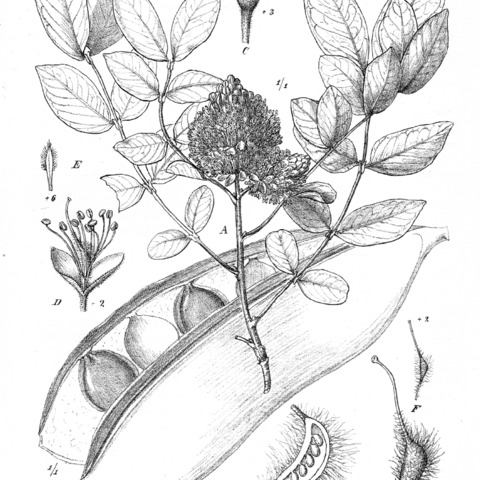Tree up to 30 m tall; bark deeply to shallowly fissured longitudinally, often coarsely reticulate or smooth, flaking in thick irregular scales, non-scaly if smooth, dark grey. Branchlets glabrous or pubescent. Leaves (3)5-20 cm long; petioles 1-5 cm long; rachis deeply canaliculate above with raised and winged margins; leaflets in 2-8 contiguous or widely spaced pairs, increasing in size distally; proximal leaflet pairs 1.5-5 x 0.5-2.5 cm, the others 3-20 x 1.5-8 cm, narrowly to broadly ovate, oblong, elliptic or lanceolate, acute, acuminate, rounded, obtuse, retuse or emarginate at the apex, obliquely round, cordate or truncate at the base, midvein central or subcentral, with 3-5 secondary veins from the proximal leaflet base. Stipules 10-40 x 1-4 mm, shortly connate at the base, erect or reflexed, filiform, linear or lanceolate, early caducous; auricles usually present, 5-25 x 1-6.5 mm, reniform to semi-circular, caducous independently of the stipules. Dormant axillary buds globose or ovoid. Inflorescences of terminal and/or axillary racemes up to 8 cm long; bracts 4-5 x 1-2 mm, caducous, ovate to oblong. Flowers 5-8 x 3-5 mm; pedicels 2-8 mm long; bracteoles 5-10 x 3-6 mm, obovate or orbicular. Sepals 0-4, 0.5-3 x 0.5-1.5 mm, linear, linear-lanceolate or rudimentary. Petals absent. Stamens 10, united to 2-7 mm at the base; filaments 10-20 mm long. Ovary 2-5 x 1-2 mm, densely pubescent, up to 7-ovulate, the stipe to 3-6 mm long; style up to 15 mm long. Pods dark brown, 8-15 x 3-5 cm, oblong to obovate; ventral flanges spreading, suberect or revolute. Seeds up to 6, 12-25 x 10-20 mm, oblong to ovoid.
A medium to large tree. It grows 8-15 m high. The branches twist and curve. The leaves hang downwards. They are dark green a and shiny. The leaflets are usually in 4 pairs. The pair of leaflets at the end are the largest. The leaflets are 2.5-8 cm long by 1-4.5 cm wide. They taper towards the tip. The base is unequal. The flowers are small and greenish. They grow in short dense spikes at the ends of branches. These are 3-6 cm long. The fruit are large woody pods. They are flattened and 14 cm long. They are dark brown and smooth when mature. The split open explosively.
Leaves (3)5–20 cm long; petioles 1–5 cm long; rachis deeply canaliculate above with raised and winged margins; leaflets in 2–8 contiguous or widely spaced pairs, increasing in size distally; proximal leaflet pairs 1.5–5 × 0.5– 2.5 cm, the others 3–20 × 1.5–8 cm, narrowly to broadly ovate, oblong, elliptic or lanceolate, acute, acuminate, rounded, obtuse, retuse or emarginate at the apex, obliquely round, cordate or truncate at the base, midvein central or subcentral, with 3–5 secondary veins from the proximal leaflet base.
Stipules 10–40 × 1–4 mm, shortly connate at the base, erect or reflexed, filiform, linear or lanceolate, early caducous; auricles usually present, 5–25 × 1–6.5 mm, reniform to semi-circular, caducous independently of the stipules.
Tree up to 30 m tall; bark deeply to shallowly fissured longitudinally, often coarsely reticulate or smooth, flaking in thick irregular scales, non-scaly if smooth, dark grey.
Inflorescences of terminal and/or axillary racemes up to 8 cm long; bracts 4–5 × 1–2 mm, caducous, ovate to oblong.
Ovary 2–5 × 1–2 mm, densely pubescent, up to 7-ovulate, the stipe to 3–6 mm long; style up to 15 mm long.
Pods dark brown, 8–15 × 3–5 cm, oblong to obovate; ventral flanges spreading, suberect or revolute.
Flowers 5–8 × 3–5 mm; pedicels 2–8 mm long; bracteoles 5–10 × 3–6 mm, obovate or orbicular.
Sepals 0–4, 0.5–3 × 0.5–1.5 mm, linear, linear-lanceolate or rudimentary.
Stamens 10, united to 2–7 mm at the base; filaments 10–20 mm long.
Seeds up to 6, 12–25 × 10–20 mm, oblong to ovoid.
Dormant axillary buds globose or ovoid.
Branchlets glabrous or pubescent.
Petals absent.


